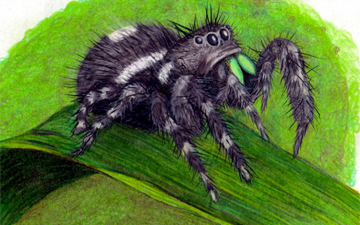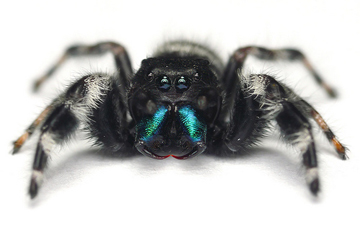Phidippus audax is a common jumping spider of North America. It is commonly referred to as the Daring Jumping Spider, or Bold Jumping Spider. The average size of adults ranges from roughly 13 to 20 mm in length.
These spiders are typically black with a pattern of spots and striped on their abdomen and legs. Often these spots are orange-tinted in juveniles, turning white as the spider matures.
The Daring Jumping Spider belongs to the genus Phidippus, a group of jumping spiders easily identified both by their relatively large size and their iridescent chelicerae. In the case of P. audax, these chelicerae are a bright, metallic green or blue.
These spiders have been known to jump up to 50 times their own body length, and the male may jump away during mating if the female approaches too quickly.[1]
Like other jumping spiders, due to their large, forward facing eyes, they have very good stereoscopic vision. This aides them when stalking prey, and allows some visual communication with others of their species, such as courting ‘dances’.
Like most jumping spiders, P. audax tends to prefer relatively open areas to hunt in, as they actively seek and stalk prey and do not build webs. They do use webbing when laying eggs or to hide. They also use spider silk as a ‘lifeline’ when jumping for prey or evading predators.
They are common in fields and grasslands, but are frequently seen on fences, exterior walls, and gardens as well. Many jumping spiders seem to prefer flat vertical surfaces, likely due to the fact that it enables them to spot and chase down roaming insects with ease.
(From Wikipedia, May 14th, 2010)
– – –
The most distinctive features on P. audax are the eight eyes. The forward-facing anterior median (AM) eyes are the largest of all the eyes. When a person looks at the spider, the AM eyes are the ones that look back at that person. To the side of the AM eyes are the smaller anterior lateral (AL) eyes. Behind the AL eyes, and almost on top of the head, are the posterior median (PM) eyes and posterior lateral (PL) eyes. Jumping spiders have very keen eyesight. Eyesight is essential for hunting and courting.
Females measure from 8 to 15 mm in length, and males are between 6 and 13 mm.
Bold jumpers are extremely hairy. The cephalothorax and abdomen are black with little, white hairs. The cephalothorax is high, heavy, and convex. The abdomen is distinctly marked. In the middle of the abdomen, there is a large, triangular white spot. There are several other spots, ranging in color from white to even yellow or orange. These spots are posterior to the central triangular spot. In some individuals there are two oblique lateral stripes. Many have chelicerae (mouthparts) that are iridescent green.
The powerful hind legs are responsible for propelling the spider into a leap. To obtain food, a jumping spider pounces on its prey. This species could not perform this difficult task without the great ability of the hind legs. (Comstock, 1980; Huntley, 1997; Jackman, 1997; Kaston, 1978)
(From EOL via Animal Diversity Web)
– – –





